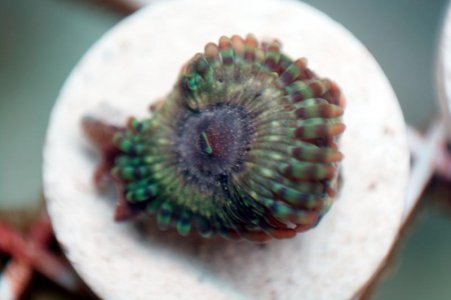Fcwham
New member
In response to Grandis' question in another thread I've compiled this information I hope you all find it useful in some way and/or it sparks discussion.
Grandis wrote:
"I would love if you could give us some examples here, with the Symbiodinium/ zoanthid's scientific names. Images, if possible. That would be great!!!"
Answering this is a little more difficult than you might think it should be because the taxonomy is a little messy but I'll try to simplify it so that we can have a discussion around it.
Host: Z. sansibaricus (AKA: Z. pacificus, Z. gnophodes, Z. erythrochloros but they are all one species and should be properly referred to as Z. sansibaricus)
Aquarium ID: Eagle Eyes, Wham'n Watermelon, Radioactive Dragon Eyes and many many more. Look for interconnected polyps with oral disks 6-10mm in size, often with pink ring around closed polyp but this is not always present so shouldn't be used as diagnostic. This may be the most common type of Zoanthus in the aquarium trade because its range extends from Africa to the Galapagos, and from Japan to Australia.
Known Symbionts: Primary symbiont Symbiodinium C3ee-ff(AKA C1z Reimer 2008) high light adapted. Other Symbionts: A1 relative found in colonies that are under light and desiccation exposure at low tide and a yet unnamed Symbiodinium C type that is found in deep and shaded colonies.
Photo 1 Z.sansibaricus, Wham'n Watermelon

Photo 2Z.sansibaricus closed polyps

Host: Z. gigantus
Aquarium ID: PPE, RPE, basicly all the people eaters. They are often referred to as "Polys" this should be actively discouraged by the community as Poly is short for Polythoa and they are not part of the Polythoa Genus. They can be identified by their larger size, often having green mouths and may display a "stripped" pattern on the closed polyps. Oral disk ranges in size from 10-25mm, some individuals may even be larger.
Known SymbiontsUnnamed C1/C3 related Symbiodinum specific to Z.gigantus found in high light environments. DNA evidence suggests that it is closely related to C3ee-ff found in Z. sansibaricus which would explain its similar lighting preferences, more sampling needs to be done to see if there is a corresponding deep/shaded symbiont.
Picture 1Z.gigantus, RPEs photo credit James Reimer

Picture 2Z.gigantus with closed polyps photo credit James Reimer

Grandis wrote:
"I would love if you could give us some examples here, with the Symbiodinium/ zoanthid's scientific names. Images, if possible. That would be great!!!"
Answering this is a little more difficult than you might think it should be because the taxonomy is a little messy but I'll try to simplify it so that we can have a discussion around it.
Host: Z. sansibaricus (AKA: Z. pacificus, Z. gnophodes, Z. erythrochloros but they are all one species and should be properly referred to as Z. sansibaricus)
Aquarium ID: Eagle Eyes, Wham'n Watermelon, Radioactive Dragon Eyes and many many more. Look for interconnected polyps with oral disks 6-10mm in size, often with pink ring around closed polyp but this is not always present so shouldn't be used as diagnostic. This may be the most common type of Zoanthus in the aquarium trade because its range extends from Africa to the Galapagos, and from Japan to Australia.
Known Symbionts: Primary symbiont Symbiodinium C3ee-ff(AKA C1z Reimer 2008) high light adapted. Other Symbionts: A1 relative found in colonies that are under light and desiccation exposure at low tide and a yet unnamed Symbiodinium C type that is found in deep and shaded colonies.
Photo 1 Z.sansibaricus, Wham'n Watermelon

Photo 2Z.sansibaricus closed polyps

Host: Z. gigantus
Aquarium ID: PPE, RPE, basicly all the people eaters. They are often referred to as "Polys" this should be actively discouraged by the community as Poly is short for Polythoa and they are not part of the Polythoa Genus. They can be identified by their larger size, often having green mouths and may display a "stripped" pattern on the closed polyps. Oral disk ranges in size from 10-25mm, some individuals may even be larger.
Known SymbiontsUnnamed C1/C3 related Symbiodinum specific to Z.gigantus found in high light environments. DNA evidence suggests that it is closely related to C3ee-ff found in Z. sansibaricus which would explain its similar lighting preferences, more sampling needs to be done to see if there is a corresponding deep/shaded symbiont.
Picture 1Z.gigantus, RPEs photo credit James Reimer

Picture 2Z.gigantus with closed polyps photo credit James Reimer



